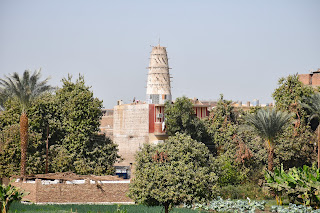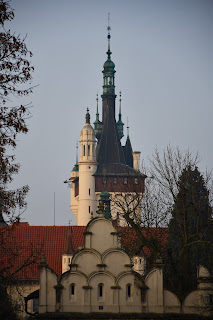An Egyptian Excursion – Day 3: Edfu and Kom Ombo
We left our ship at half past seven to board the tour bus to the nearby temple of Edfu. While the site’s history dates to the third millennium BCE, the famous ruins visited today were built under the Ptolemies: The work began in 237 BCE and was only completed one hundred and eighty years later. As pointed out by the introduction of Cavafy’s Collected Poems, the Ptolemies were in fact the longest-reigning dynasty of Egypt, which I find quite remarkable. This dating makes the temple comparatively young but in no way detracts from its splendour. Buried in the sand for centuries, Edfu retains its hieroglyphs, Horus statues, and some of its colour as well as the ceiling atop its massive pillars.
Our early
arrival did little to help us beat the crowds, as everyone else seemed to have
the exact same itinerary. The whole navy that queued with us yesterday to cross
the lock at Esna had also moored in Edfu for the night, and many of these ships
accompanied us on our way to Kom Ombo before continuing to Aswan. We left our
ship by crossing the lobbies of four other ships that lined up next to each
other by the pier. They all seemed to have the same height and proportions,
though each of the lobbies had a distinct touch and furnishings. I felt concern
about the number of people, as the jostling crowds bumped into the walls and
rubbed their bodies on the hieroglyphs in the narrower passages. I will not be
surprised if, in the future, the authorities decide to monitor the number of
tourists or perhaps start closing off the tighter spaces.
Our ship
left Edfu at half past ten, that is, half an hour later than it was supposed
to, because we had to wait for the ships that had piled up around us to vacate
the pier. We then continued upstream to the Temple at Kom Ombo. Along the way,
I watched the cows graze on the Nile’s green branks as the houses grew sparser
and sparser. Occasionally, there would be one with a mud-and-brick roof
supported by jutting wooden crossbeams like they do at the great buildings of
Timbuktu. The land beyond the banks flattened out as we neared Kom Ombo; all we
saw were the rocky banks, the grass and bushes growing on them, and the palm
trees jutting above the green groves right into the sky, with desert hills no
longer looming in the background.
Kom Ombo
came into sight at half past three, its pillars rising majestically above the
east bank of the Nile. We left for the temple at four and stayed there for an
hour and a half. The Temple of Kom Ombo is remarkable for being dedicated to
two gods: Sobek and Horus. Sobek took the form of a crocodile and originally
defended people from being killed by the beast. In later years he became the
river god, and one account says the Nile was created from his sweat; some
images at the temple of Kom Ombo even honour him by identifying him with the
sun. This bizarre pairing makes some sense, as crocodiles were probably
observed basking in the sun throughout the day and disappearing in the night.
Horus,
depicted at Kom Ombo in his mature form as Haroeris, was the god of the sun,
the sky, and kingship. He took the form of a falcon. Egyptian myth has it that
Horus was the son of Isis, the goddess of magic and fate, and Osiris, the god
of resurrection and thus the patron of agriculture and the afterlife. After Set
slew Osiris, whose scattered body pieces were dutifully collected by his wife
to create the first mummy, Horus sought to avenge his father in battle. The contest
between Set and Horus is sometimes said to symbolise the struggle between Upper
and Lower Egypt, though there is another reading that equates Set with desert
and chaos, and Horus with order and the civilised world around the Nile. Horus
eventually won but Set retained control over his own domains.
Kom Ombo’s
focus on Sobek makes it a unique attraction among the largest temples of
Ancient Egypt. In addition to its crocodile carvings, the site also houses a
museum with a very interesting collection: just a few kilometres away from the
temple lies a burial place where archaeologists have unearthed several dozen
crocodile mummies. These can now be seen behind a glass in a dark room, where a
few information boards provide basic information about Sobek and the Ancient
Egyptian practice of mummifying animals associated with the gods.
Nothing
very noteworthy happened after our visit to Kom Ombo; our being besieged by an
army of souvenir sellers of all ages hardly deserves mention anymore. A
particularly persistent boy came up to us asking “What are you from?” and I
could not restrain myself from explaining the phrase to him until he said it
properly. After a fleeting moment of conviction that he had found the weak link
in the group, he relented and took leave with an amicable handshake. Our ship
left again at around six o’clock and began its course toward our group’s final
stop: the city of Aswan. We were served dinner at half past seven, but I sought
to fall asleep as early as I could: We had to wake up at two o’clock the very
next day to start our long ride to Abu Simbel.



























Comments
Post a Comment